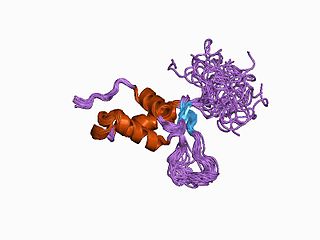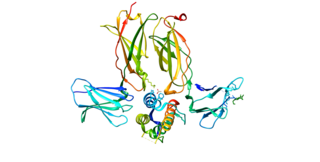FOXproteins are a family of transcription factors that play important roles in regulating the expression of genes involved in cell growth, proliferation, differentiation, and longevity. Many FOX proteins are important to embryonic development. FOX proteins also have pioneering transcription activity by being able to bind condensed chromatin during cell differentiation processes.

Forkhead box protein C2 (FOXC2) also known as forkhead-related protein FKHL14 (FKHL14), transcription factor FKH-14, or mesenchyme fork head protein 1 (MFH1) is a protein that in humans is encoded by the FOXC2 gene. FOXC2 is a member of the fork head box (FOX) family of transcription factors.

Forkhead box protein P1 is a protein that in humans is encoded by the FOXP1 gene. FOXP1 is necessary for the proper development of the brain, heart, and lung in mammals. It is a member of the large FOX family of transcription factors.

Forkhead box O3, also known as FOXO3 or FOXO3a, is a human protein encoded by the FOXO3 gene.

Runt-related transcription factor 3 is a protein that in humans is encoded by the RUNX3 gene.

NK2 homeobox 1 (NKX2-1), also known as thyroid transcription factor 1 (TTF-1), is a protein which in humans is encoded by the NKX2-1 gene.

Paired-like homeodomain transcription factor 2 also known as pituitary homeobox 2 is a protein that in humans is encoded by the PITX2 gene.

Forkhead box C1, also known as FOXC1, is a protein which in humans is encoded by the FOXC1 gene.

Forkhead box protein L2 is a protein that in humans is encoded by the FOXL2 gene.

Forkhead box protein E1 is a protein that in humans is encoded by the FOXE1 gene.

Thymic stromal lymphopoietin (TSLP) is an interleukin (IL)-2-like cytokine, alarmin, and growth factor involved in numerous physiological and pathological processes, primarily those of the immune system. It shares a common ancestor with IL-7.

E74-like factor 5 , is a gene found in both mice and humans. In humans it is also called ESE2.

ETS homologous factor is a protein that in humans is encoded by the EHF gene. This gene encodes a protein that belongs to an ETS transcription factor subfamily characterized by epithelial-specific expression (ESEs). The encoded protein acts as a transcriptional repressor and may be associated with asthma susceptibility. This protein may be involved in epithelial differentiation and carcinogenesis.

Forkhead box protein F1 (FOXF1) is a protein that in humans is encoded by the FOXF1 gene.

Forkhead box protein N1 is a protein that in humans is encoded by the FOXN1 gene.

Forkhead box protein A1 (FOXA1), also known as hepatocyte nuclear factor 3-alpha (HNF-3A), is a protein that in humans is encoded by the FOXA1 gene.

Forkhead box protein A2 (FOXA2), also known as hepatocyte nuclear factor 3-beta (HNF-3B), is a transcription factor that plays an important role during development, in mature tissues and, when dysregulated or mutated, also in cancer.

Forkhead box protein E3 (FOXE3) also known as forkhead-related transcription factor 8 (FREAC-8) is a protein that in humans is encoded by the FOXE3 gene located on the short arm of chromosome 1.

Cadherin related family member 3 (CDHR3), also known as CDH28 or its abbreviation CDHR3, is a protein that in humans is encoded by the CDHR3 gene. The protein is predominately expressed in respiratory epithelium and the first notion of its clinical implications was from the discovery that genetic variation of CDHR3 is strongly associated to early severe asthma exacerbations in children. Subsequent studies have suggested that CDHR3 is a receptor for a subtype of rhinovirus.

Grainyhead-like genes are a family of highly conserved transcription factors that are functionally and structurally homologous across a large number of vertebrate and invertebrate species. For an estimated 100 million years or more, this genetic family has been evolving alongside life to fine tune the regulation of epithelial barrier integrity during development, fine-tuning epithelial barrier establishment, maintenance and subsequent homeostasis. The three main orthologues, Grainyhead-like 1, 2 and 3, regulate numerous genetic pathways within different organisms and perform analogous roles between them, ranging from neural tube closure, wound healing, establishment of the craniofacial skeleton and repair of the epithelium. When Grainyhead-like genes are impaired, due to genetic mutations in embryogenesis, it will cause the organism to present with developmental defects that largely affect ectodermal tissues in which they are expressed. These subsequent congenital disorders, including cleft lip and exencephaly, vary greatly in their severity and impact on the quality of life for the affected individual. There is much still to learn about the function of these genes and the more complex roles of Grainyhead-like genes are yet to be discovered.






















